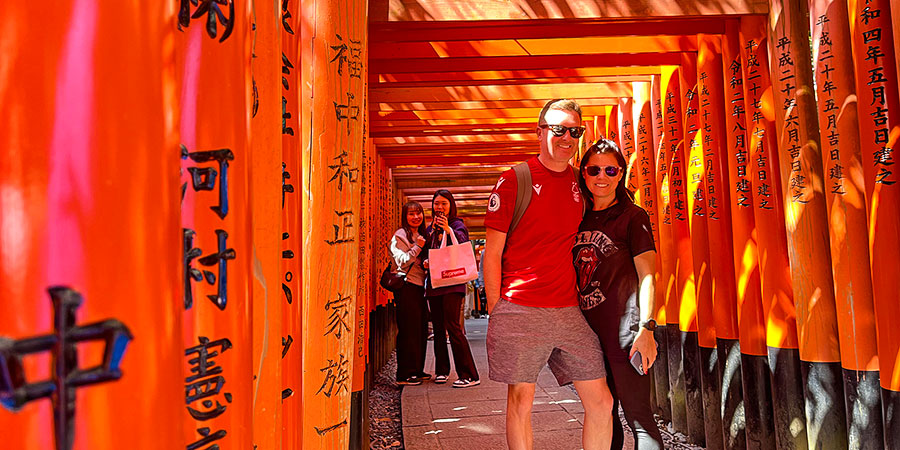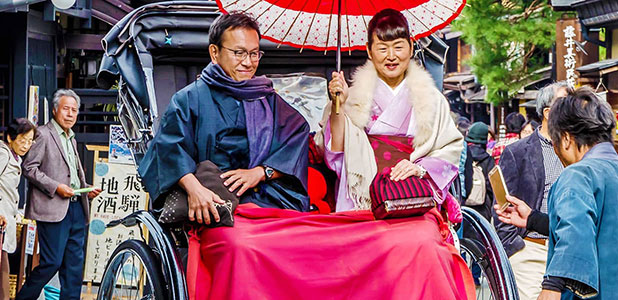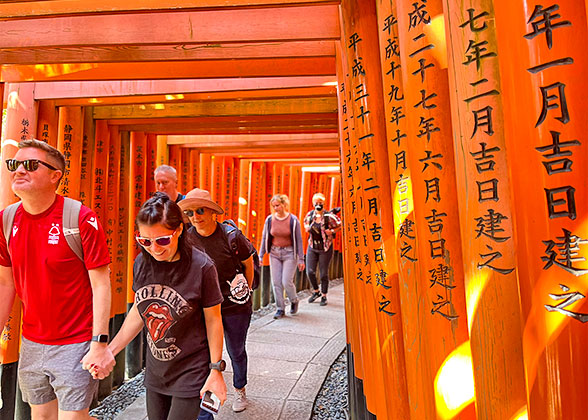Kyoto Attractions
Kyoto, the ancient capital of Japan from 794 AD to 1868 AD, manifests the soul and spirit of Japanese traditional culture. Traveling here is like stepping into Japan’s ancient past, which has bestowed upon it an untold number of historic constructions, with 17 treasured as UNESCO World Heritage Sites. With that said, a list of top attractions and other important sites have been prepared for visitors to plan Kyoto travel itineraries.
Kyoto Top Attractions

Fushimi Inari Taisha
|
|
The shrine with thousands of torri gates
Fushimi Inari Taisha, or Fushimi Inari Shrine, dates back to the 8th century. It enshrines Inari, the most worshipped Shinto deity of rice and commerce. The image of the shrine is always associated the iconic vermillion Senbon Torii, or thousands of torri gates, that cover a trail all the way from the base of Mount Inari to its top.
|
|

Kiyomizu-dera Temple
|
|
A temple with main hall erected without a single nail
UNESCO-preserved, Kiyomizu-dera Temple (Pure Water Temple) has been 1,200 years old. The main hall, dedicated to the Buddhist goddess of mercy and with a famous terrace to look over the compound and Kyoto’s cityscape, was engineered without using a nail. People also flock here to pray by drinking “pure” water from its Otowa Waterfall, which the temple was derived from.
|
|

Ninenzaka and Sannenzaka
|
|
Ancient streets with "no" power poles and wires
Built in the 9th century, Sannenzaka and Ninenzaka are the sloping approach to Kiyomizu-dera Temple. With poles and wires hidden, they enjoy an ancient vibe that doesn’t belong to the modern world. Traditional wooden buildings on either side have changed to shops, cafes, and inns.
|
|

Yasaka Shrine
|
|
Holds Japan’s most celebrated Gion Festival
Yasaka Shrine, fondly called Gion Shrine, is the birthplace of Gion Festival, the grandest in Japan that lasts for an entire month of July to purge Kyoto of mischievous spirits. Besides the evil-feared sea of god, the Shrine also enshrines goddesses of beauty, explaining why it’s loved by girls.
|
|

Gion
|
|
No.1 place to experience Geisha culture
The district before Yasaka Shrine is called Gion, where Geisha culture originated centuries ago. The spotting of Geisha, female artists serving high-class social gatherings, is the most popular activity here. Flanking Gion streets, traditional buildings and some 300-year-old ochaya tea houses will take you to Japan’s Edo era.
|
|

Nishiki Market
|
|
Kitchen of Kyoto, offering free food samples
Visit other places to learn Japan’s history and Nishiki Market to eat - simple as that. Life and offerings here have made this street known across Japan. Starting as a fish wholesale market, it’s now retailing various traditional snacks, with many shops providing free samples.
|
|

Nijo Castle
|
|
Represents supreme Edo-era military power
Nijo Castle was the imperially grand base of the Tokugawa Shogunate in Kyoto, the supreme Edo-era military power over Japanese emperors. Apart from the architecture, here you can also appreciate originals of ancient telltale artworks indicating Tokugawa’s prestige.
|
|

Kinkaku-ji Temple
|
|
Temple of the Golden Pavilion
Kinkaku-ji Temple is a UNESCO-preserved Zen temple sheltering Golden Pavilion, which draws people from beyond Japan with its gold leaf and a curious blend of different architectural styles. Together with the glassy pond, which reflects its poise, the Pavilion is definitely an iconic sight of Kyoto.
|
|
See More Attractions
 Sanjusangendo Temple: The world's longest wooden structure, Sanjusangendo harbors 1,001 statues of thousand-armed Kannon, the Buddhist goddess of mercy.
Sanjusangendo Temple: The world's longest wooden structure, Sanjusangendo harbors 1,001 statues of thousand-armed Kannon, the Buddhist goddess of mercy.
 Arashiyama
Arashiyama: Once an imperial retreat, Arashiyama is now a Place of Scenic Beauty of Japan at the foot of Arashiyama mountains. Its Togetsu-kyo Bridge and Arashiyama Bamboo Grove are iconic landmarks of Kyoto.
 Kennin-ji Temple
Kennin-ji Temple: The oldest Zen temple in Kyoto.
 Maruyama Park
Maruyama Park: A park famous for over 680 cherry trees and a spectacular Weeping Cherry of Gion know across Japan.
 Philosopher’s Path: A long path for cherry blossom viewing following a canal, along which there are many shrines and famous temples.
Philosopher’s Path: A long path for cherry blossom viewing following a canal, along which there are many shrines and famous temples.

Blooming Sukura in Kyoto
|
 Kyoto Imperial Palace
Kyoto Imperial Palace: The palace of ancient Japanese emperors before 1868 for a thousand years.
 Higashiyama Jisho-ji Temple: Aka Ginkaku-ji Temple, the temple is UNESCO-listed and where a shogun lived, with an architecture representing Zen aesthetics.
Higashiyama Jisho-ji Temple: Aka Ginkaku-ji Temple, the temple is UNESCO-listed and where a shogun lived, with an architecture representing Zen aesthetics.
 Toji Temple: The UNESCO-honored center of Japanese Esoteric Buddhism, it was a guardian of Kyoto city at the ancient times.
Toji Temple: The UNESCO-honored center of Japanese Esoteric Buddhism, it was a guardian of Kyoto city at the ancient times.
 Kyoto Railway Museum: The museum that tells the story of Japan's complex railway systems and where to find displayed retired trains, including steam locomotives.
Kyoto Railway Museum: The museum that tells the story of Japan's complex railway systems and where to find displayed retired trains, including steam locomotives.
 TOEI Kyoto Studio Park: Japan's first theme park to find the Edo-era world seen in Japanese historical dramas; it's a must-visit for fans of Japanese cinema and cosplay.
TOEI Kyoto Studio Park: Japan's first theme park to find the Edo-era world seen in Japanese historical dramas; it's a must-visit for fans of Japanese cinema and cosplay.

Arashiyama in Autumn
|
 Heian Shrine: Also known as Heian Jingu Shrine, it's a relatively "new" shrine constructed in 1895 as a commemoration of the 1,100th anniversary of Kyoto’s being the capital of Japan.
Heian Shrine: Also known as Heian Jingu Shrine, it's a relatively "new" shrine constructed in 1895 as a commemoration of the 1,100th anniversary of Kyoto’s being the capital of Japan.
 Kamo River: Kamogawa River is a 31-km-long river flowing through the heart of Kyoto. It's an attractive place for strolling, jogging and experiencing Kyoto's culture.
Kamo River: Kamogawa River is a 31-km-long river flowing through the heart of Kyoto. It's an attractive place for strolling, jogging and experiencing Kyoto's culture.
 Pontocho: A 500-meter-long street with traditional Japanese style architecture. It's also a good spot to experience geisha culture.
Pontocho: A 500-meter-long street with traditional Japanese style architecture. It's also a good spot to experience geisha culture.
 Katsura Imperial Villa: One of three major imperial gardens in Japan.
Katsura Imperial Villa: One of three major imperial gardens in Japan.
 Japan Attractions
Japan Attractions  Tokyo Attractions
Tokyo Attractions  Kyoto Photos
Kyoto Photos

![]() Sanjusangendo Temple: The world's longest wooden structure, Sanjusangendo harbors 1,001 statues of thousand-armed Kannon, the Buddhist goddess of mercy.
Sanjusangendo Temple: The world's longest wooden structure, Sanjusangendo harbors 1,001 statues of thousand-armed Kannon, the Buddhist goddess of mercy.
![]() Philosopher’s Path: A long path for cherry blossom viewing following a canal, along which there are many shrines and famous temples.
Philosopher’s Path: A long path for cherry blossom viewing following a canal, along which there are many shrines and famous temples.

![]() Higashiyama Jisho-ji Temple: Aka Ginkaku-ji Temple, the temple is UNESCO-listed and where a shogun lived, with an architecture representing Zen aesthetics.
Higashiyama Jisho-ji Temple: Aka Ginkaku-ji Temple, the temple is UNESCO-listed and where a shogun lived, with an architecture representing Zen aesthetics.
![]() Toji Temple: The UNESCO-honored center of Japanese Esoteric Buddhism, it was a guardian of Kyoto city at the ancient times.
Toji Temple: The UNESCO-honored center of Japanese Esoteric Buddhism, it was a guardian of Kyoto city at the ancient times.![]() Kyoto Railway Museum: The museum that tells the story of Japan's complex railway systems and where to find displayed retired trains, including steam locomotives.
Kyoto Railway Museum: The museum that tells the story of Japan's complex railway systems and where to find displayed retired trains, including steam locomotives.
![]() TOEI Kyoto Studio Park: Japan's first theme park to find the Edo-era world seen in Japanese historical dramas; it's a must-visit for fans of Japanese cinema and cosplay.
TOEI Kyoto Studio Park: Japan's first theme park to find the Edo-era world seen in Japanese historical dramas; it's a must-visit for fans of Japanese cinema and cosplay.

![]() Heian Shrine: Also known as Heian Jingu Shrine, it's a relatively "new" shrine constructed in 1895 as a commemoration of the 1,100th anniversary of Kyoto’s being the capital of Japan.
Heian Shrine: Also known as Heian Jingu Shrine, it's a relatively "new" shrine constructed in 1895 as a commemoration of the 1,100th anniversary of Kyoto’s being the capital of Japan.
![]() Kamo River: Kamogawa River is a 31-km-long river flowing through the heart of Kyoto. It's an attractive place for strolling, jogging and experiencing Kyoto's culture.
Kamo River: Kamogawa River is a 31-km-long river flowing through the heart of Kyoto. It's an attractive place for strolling, jogging and experiencing Kyoto's culture.![]() Pontocho: A 500-meter-long street with traditional Japanese style architecture. It's also a good spot to experience geisha culture.
Pontocho: A 500-meter-long street with traditional Japanese style architecture. It's also a good spot to experience geisha culture.
![]() Katsura Imperial Villa: One of three major imperial gardens in Japan.
Katsura Imperial Villa: One of three major imperial gardens in Japan.![]() Japan Attractions
Japan Attractions ![]() Tokyo Attractions
Tokyo Attractions ![]() Kyoto Photos
Kyoto Photos







